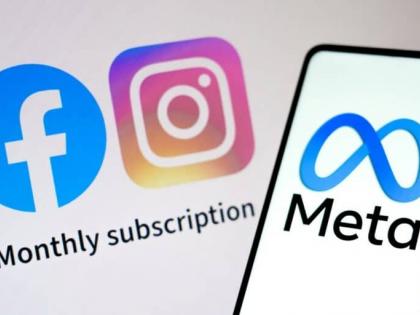Meta’s New Subscription Model: A Tough Sell for India?
October 6, 2025
Meta’s New Subscription Model: A Tough Sell for India? – www.lokmattimes.com
Home
City
Latest News
Cricket
LT Premium
National
International
Maharashtra
Opinions
Chhatrapati Sambhajinagar
Nagpur
Entertainment
Photos
Business
Technology
Sports
Lifestyle
Social Viral
Lokmat Games
Health
By Hemant Jain | Updated: October 6, 2025 11:29 IST2025-10-06T11:28:30+5:302025-10-06T11:29:45+5:30
Meta, the parent company of Facebook and Instagram, has introduced a new subscription-based model for users in the UK. …

Meta, the parent company of Facebook and Instagram, has introduced a new subscription-based model for users in the UK. This model gives users the choice between paying for an ad-free experience or sticking with the platforms’ free, ad-supported options. In the UK, the subscription costs £2.99 per month for web users and £3.99 for mobile users. When converted to Indian rupees, this equates to approximately ₹299/month for web users and ₹399/month for mobile users. The Information Commissioner’s Office (ICO), the UK’s data watchdog, welcomed this shift, viewing it as a step towards greater compliance with data privacy regulations. However, whether this model will take off in India, a market with distinct digital behaviors and regulatory conditions, is still uncertain.
The Unique Indian Market: A Different Landscape
Low Adoption Rates Expected
The concept of paying for ad-free content hasn’t gained significant traction in India something we’ve so far only associated with OTT platforms. Despite the growing popularity of digital services, Indian users are highly price-sensitive and typically prefer free, ad-supported models. For example, YouTube Premium has only around 1% to 1.5% adoption from its massive Indian user base, despite being priced at ₹129/month. Given this, Meta’s ad-free model may face similar resistance, as most Indian users are accustomed to free access with ads. The high-volume, low-cost approach that dominates the Indian market contrasts sharply with the willingness of users in Western countries to pay for an ad-free experience.
Price Sensitivity: A Major Hurdle
Meta’s ₹299 (web) and ₹399 (mobile) subscription model may struggle in India, where services like YouTube Premium have seen limited success at ₹129/month. To gain traction, Meta might need to introduce an Ultra-Low-Cost Tier (ULCT) priced between ₹89-₹99/month. Even at this lower price, convincing users to pay for a service they’re used to getting for free could be challenging. Many users would rather tolerate ads than pay a monthly fee, especially when the current offerings are free.,
Revenue Impact: Ad Revenue Still King
Even if Meta’s subscription model manages to attract some paying users in India, the revenue generated would likely be minimal compared to the ad-based revenue it currently earns. For example, YouTube Premium and Music are projected to generate ₹388 crore to ₹679 crore monthly by 2025, but this is a small fraction compared to YouTube’s total ad revenue in India. Similarly, Meta would likely see subscriptions as a minor revenue stream, with its ad-supported model.
Impact on Small and Medium Businesses (SMBs)
A widespread shift to ad-free experiences could pose challenges for small and medium businesses (SMBs) in India. Many SMBs rely on Meta’s low-cost advertising options to reach potential customers. If more users opt for the ad-free subscription, the reach of organic ads would decline, potentially forcing businesses to increase their Customer Acquisition Costs (CAC). This shift could drive SMBs to adopt more targeted, AI-driven advertising solutions, which may increase costs and reduce the effectiveness of their campaigns.
Influencer Marketing Shift
Influencer marketing could undergo a significant shift in India, particularly with the decline in the organic reach of traditional ads. Brands would likely turn to micro and nano influencers—those with smaller but highly engaged audiences—as a more cost-effective and authentic alternative to mass-market campaigns. Influencers offering localized, value-driven content would be seen as more effective at converting audiences, which could shift brand strategies away from broad reach to more niche, but impactful, influencer collaborations.
Ads Will Likely Dominate
The performance of YouTube Premium in India offers useful insights into how Meta’s subscription model might fare. With over 491 million users in India, YouTube has only converted about 1% of its users to its paid subscription model, a stark reminder of the challenges Meta will face in convincing Indian users to pay for an ad-free experience. For the vast majority of users, the free, ad-supported model remains preferable. Consequently, businesses, influencers, and users alike can expect advertising to continue as the primary revenue driver for Meta in India, at least for the foreseeable future. While Meta’s subscription model may eventually find a niche audience, it will struggle to become a mainstream offering in India as of now.
Tags :Meta New Subscription ModelMetaFacebookInstagramOtt platforms
Search
RECENT PRESS RELEASES
Related Post


